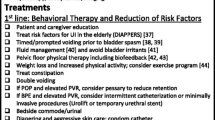Abstract
Introduction and hypothesis
Anticholinergic medication is the medical treatment for overactive bladder (OAB). These drugs can act on the central nervous system and can lead to cognitive decline, dementia, and potentially death. Patients taking drugs with anticholinergic effects increase their anticholinergic burden—defined as the cumulative effect of taking one or more drugs that can have adverse effects. When prescribing anticholinergic medication for the elderly, we must choose the right drug. We aimed to discover the level of understanding on this subject and its application to real clinical practice amongst our healthcare professionals (HCPs).
Methods
An 18-point questionnaire was distributed to urogynaecologists, general gynaecologists, urologists, geriatricians, general practitioners (GPs), and nurse specialists to assess knowledge on the subject.
Results
A total of 96 HCPs completed the questionnaire. The nurse specialists had the highest score in identifying that oxybutynin was the drug most likely to cross the blood–brain barrier (BBB). The urogynaecologists had the highest score in identifying that trospium chloride was least likely to cross the BBB, whereas the GPs had the lowest score. Solifenacin was the most popular anticholinergic drug prescribed in the elderly without dementia. Trospium chloride was the most popular drug prescribed in the elderly with dementia.
Conclusions
We have found that knowledge is lacking amongst all our HCPs, but especially amongst our first-line doctors, our GPs. Education is key in developing knowledge and safe prescribing, to improve the care we give to our patients.



Similar content being viewed by others
References
Haylen BT, de Ridder D, Freeman RM, et al. An International Urogynecological Association (IUGA)/International Continence Society (ICS) joint report on the terminology for female pelvic floor dysfunction. Int Urogynecol J. 2010;21:5–26. doi:10.1007/s00192-009-0976-9.
Milsom I, Abrams P, Cardozo L, Roberts RG, Thüroff J, Wein AJ. How widespread are the symptoms of an overactive bladder and how are they managed? A population‐based prevalence study. BJU Int. 2001;87(9):760–6. doi:10.1046/j.1464-410x.2001.02228.x.
McGrother CW, Donaldson MM, Shaw C, et al. Storage symptoms of the bladder: prevalence, incidence and need for services in the UK. BJU Int. 2004;93(6):763–9. doi:10.1111/j.1464-410X.2003.04721.x.
Kay GG, Granville LJ. Antimuscarinic agents: implications and concerns in the management of overactive bladder in the elderly. Clin Ther. 2005;27(1):127–38. doi:10.1016/j.clinthera.2005.01.006.
Fox C, Smith T, Maidment I, et al. Effect of medications with anti-cholinergic properties on cognitive function, delirium, physical function and mortality: a systematic review. Age Ageing. 2014;43(5):604–15. doi:10.1093/ageing/afu096.
Wagg A, Nitti VW, Kelleher C, Castro-Diaz D, Siddiqui E, Berner T. Oral pharmacotherapy for overactive bladder in older patients: mirabegron as a potential alternative to antimuscarinics. Curr Med Res Opin. 2016;32(4):621–38. doi:10.1185/03007995.2016.1149806.
Chancellor M, Boone T. Anticholinergics for overactive bladder therapy: central nervous system effects. CNS Neurosci Ther. 2012;18(2):167–74. doi:10.1111/j.1755-5949.2011.00248.
Kersten H, Wyller TB. Anticholinergic drug burden in older people’s brain–How well is it measured? Basic Clin Pharmacol Toxicol. 2014;114(2):151–9. doi:10.1111/bcpt.12140.
Chancellor MB, Staskin DR, Kay GG, Sandage Jr BW, Oefelein MG, Tsao JW. Blood–brain barrier permeation and efflux exclusion of anticholinergics used in the treatment of overactive bladder. Drugs Aging. 2012;29(4):259–73. doi:10.2165/11597530-000000000-00000.
Tune LE. Anticholinergic effects of medication in elderly patients. J Clin Psychiatry. 2001;62 Suppl 21:11–4.
Fox C, Richardson K, Maidment ID, et al. Anticholinergic medication use and cognitive impairment in the older population: the medical research council cognitive function and ageing study. J Am Geriatr Soc. 2011;59(8):1477–83. doi:10.1111/j.1532-5415.2011.03491.x.
Salom IL, Davis K. Prescribing for older patients: how to avoid toxic drug reactions. Geriatrics. 1995;50(10):37–40.
Perry EK, Kilford L, Lees AJ, Burn DJ, Perry RH. Increased Alzheimer pathology in Parkinson’s disease related to antimuscarinic drugs. Ann Neurol. 2003;54(2):235–8. doi:10.1002/ana.10639.
Gray SL, Anderson ML, Dublin S, et al. Cumulative use of strong anticholinergics and incident dementia: a prospective cohort study. JAMA Intern Med. 2015;175(3):401–7. doi:10.1001/jamainternmed.2014.7663.
Villalba-Moreno AM, Alfaro-Lara ER, Pérez-Guerrero MC, Nieto-Martín MD, Santos-Ramos B. Systematic review on the use of anticholinergic scales in poly pathological patients. Arch Gerontol Geriatr. 2016;62:1–8. doi:10.1016/j.archger.2015.10.002.
Durán CE, Azermai M, Vander Stichele RH. Systematic review of anticholinergic risk scales in older adults. Eur J Clin Pharmacol. 2013;69(7):1485–96. doi:10.1007/s00228-013-1499-3.
Tune LE, Egeli S. Acetylcholine and delirium. Dement Geriatr Cogn Disord. 1999;10(5):342–4. doi:10.1159/000017167.
National Collaborating Centre for Women’s and Children’s Health (UK). Urinary incontinence in women: the management of urinary incontinence in women. London: RCOG Press; 2006.
Abrams P, Cardozo L, Khoury S, Wein AJ. Incontinence, 5th international consultation on incontinence. Paris: ICUD-EAU; 2013. p. 1913–5.
Author information
Authors and Affiliations
Corresponding author
Ethics declarations
Conflicts of interest
None.
Rights and permissions
About this article
Cite this article
Araklitis, G., Thiagamoorthy, G., Hunter, J. et al. Anticholinergic prescription: are healthcare professionals the real burden?. Int Urogynecol J 28, 1249–1256 (2017). https://doi.org/10.1007/s00192-016-3258-3
Received:
Accepted:
Published:
Issue Date:
DOI: https://doi.org/10.1007/s00192-016-3258-3




